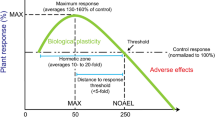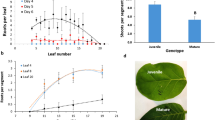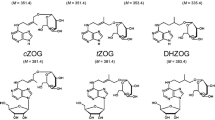Abstract
HYPOCOTYLS of intact flax plants (Linum usit-atissimum L.) rarely develop buds. If decapitated, the young hypocotyl initiates adventitious buds some of which develop into flowering shoots1. The result is the same if both the cotyledonary buds and the epicotyl are removed, but the cotyledons are allowed to remain. Hypocotyls of plants with cotyledons and the young epicotyl enclosed in a plaster cast remain budless. Segments of hypocotyls2and of internodes occasionally initiate buds. These findings suggested that bud initiation is under hormonal control which is disturbed by partial or complete isolation.
This is a preview of subscription content, access via your institution
Access options
Subscribe to this journal
Receive 51 print issues and online access
$199.00 per year
only $3.90 per issue
Buy this article
- Purchase on Springer Link
- Instant access to full article PDF
Prices may be subject to local taxes which are calculated during checkout
Similar content being viewed by others
References
Reichardt, H. W., "Beiträage zur Kenntniss hypokotylischer Adventivknospen und Wurzelsprosse bei krautigen Dikotylen." Wien, 1857.
Neubert, H., "Ersatzbildung beim Flachs", Faserforschung, 9, 9–63 (1931).
Crooks, D. M., "Histological and Regenerative Studies of the Flax Seedling", Bot. Gaz., 95, 209–239 (1933).
Greenleaf, W. H., "Induction of Polyploidy in Mcotiana", Science, N.S., 86, 565–566 (1937).
Beal, J. M., "Bud Development in Lilium harrisii following Treat-ment with Indole-Acetic Acid", Proc. Nat. Acad. Sci., 23, 304–306 (1937).
Goldberg, E., "Root and Shoot Production induced in Cabbage by beta-3 Indole-Acetic Acid", Science, N.S., 87, 511–512 (1938).
Laibach, F., Mai, G., and Müller, A., "Über ein Zellteilungs-Hormon." Naturwiss., 22, 288 (1934).
Link, G., Wilcox, H., and Link, A. DeS., "Responses of Bean and Tomato to Phytomonas tumefaciens, P. tumefaciens Extracts, beta-Indoleacetic acid, and Wounding", Bot. Gaz., 98, 816–867 (1937).
Bonner, J., and English, J., "A Chemical and Physiological Study of Traumatin, a Plant Wound Hormone", Plant Physiol., 13. 331–347 (1938).
Went, F. W., "Allgemeine Betrachtungen über das Auxin-Problem" Biol. Zentblatt., 56, 449–463 (1936).
Went, F. W., "Specific Factors other than Auxin affecting Growth and Root Formation", Plant Physiol., 13, 55–81 (1938).
Author information
Authors and Affiliations
Rights and permissions
About this article
Cite this article
LINK, G., EGGERS, V. Inhibition of Adventitious Bud Initiation in Hypocotyls of Flax by Indole-3-Acetic Acid and Flax Extract. Nature 142, 398–399 (1938). https://doi.org/10.1038/142398a0
Issue Date:
DOI: https://doi.org/10.1038/142398a0
This article is cited by
-
Zur Kenntnis der Morphologie und des Wuchsstoffverhaltens der Oenothera Hybrida mut. Helix
Zeitschrift f�r Induktive Abstammungs- und Vererbungslehre (1955)
Comments
By submitting a comment you agree to abide by our Terms and Community Guidelines. If you find something abusive or that does not comply with our terms or guidelines please flag it as inappropriate.



